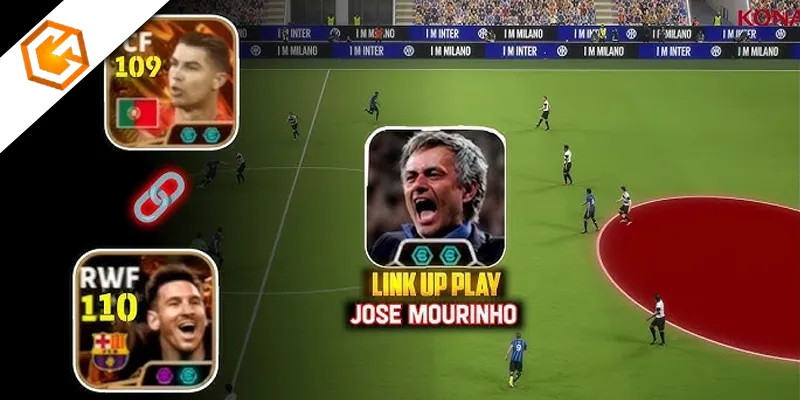You want your link-up play to translate into goals, not sterile possession. Start by matching a manager’s profile to your squad’s roles—pair a creative Centrepiece with a decisive Key Man, then choose a playstyle that fits, whether patient possession or sharp counters. Focus on formations that create natural triangles and quick lanes. From attributes to on-field triggers, small tweaks compound fast. The tricky part is knowing when to switch gears—and that’s where most managers stumble.
Key Takeaways
- Pair a creative Centrepiece with a pacey Key Man; align traits like vision and finishing to trigger automatic Link-Up Play sequences.
- Choose managers matching your squad: counterattacking boosts anticipation and release timing; possession-minded improves passing quality and support distances.
- Use 4-3-3 for rapid flank-to-centre switches, 4-2-3-1 for short triangles, 3-5-2 for vertical one-twos, or 4-4-2 diamond for compact combinations.
- Activate Link-Up Play to accelerate combinations and high-xG chances; deactivate when spaces tighten or pressing compresses passing lanes.
- Train Centrepiece–Key Man drills, monitor Key Man starting positions, and adjust width/roles mid-match to maintain optimal passing angles.
Understanding Link-Up Play Mechanics
Although it looks simple on the surface, Link-Up Play in eFootball 2026 hinges on pairing the right Centrepiece with the right Key Man and fitting them into a tactical setup that amplifies their strengths. You’ll get results only when both roles match positional and playstyle requirements. Pick a creative Centrepiece who can dictate tempo and release the Key Man with precise passes. Choose a Key Man whose movement, finishing, or hold-up traits directly benefit from that supply.
Your tactical setup then elevates key attributes. For instance, an aggressive counter approach can boost passing speed and quality, letting the Centrepiece thread riskier balls reliably. Toggle Link-Up Play on when you need sharper combinations or high-probability chances, and switch it off if space closes. Activation won’t affect squad ratings.
Key Manager Profiles and Playstyles
Because managers define tempo, spacing, and risk, your Link-Up Play lives or dies by the coach you choose. You’ll feel it immediately: the right manager sharpens passing lanes, times runs, and clarifies the roles of your Centrepiece and Key Man.
Pick profiles that amplify your intended rhythm. If you want ruthless transitions, a counterattacking specialist like Jose Mourinho boosts key attributes during Link-Up Play—anticipation, defensive compactness, and release timing—so your outlets receive cleaner balls and your runners hit top speed sooner. Prefer measured control? Choose a possession-minded coach who upgrades passing quality and support distances, keeping combinations tight and repeatable.
Always align managerial style with your squad’s traits. When compatibility matches tactics, Link-Up Play becomes automatic: quicker wall passes, smarter decoy runs, and higher‑value shots.
Optimal Formations for Fluid Passing
With your manager’s profile set, shape the pitch to match their rhythm by choosing formations that keep passes flowing. Prioritize shapes that link midfield lines and create width. The 4-3-3 excels for Link-Up Play: wingers stretch defenses while the Centrepiece and Key Man interchange through quick transitions. If you prefer tighter control, the 4-2-3-1 supports short passing triangles and steady possession. A 3-5-2 unlocks overlapping wing-backs, opening lanes for vertical one-twos. The 4-4-2 diamond compresses the midfield, enabling rapid one-touch combinations and constant support around the ball. For possession managers, choose systems that stack midfield connections and ensure easy outlets.
| Formation | Passing Focus | Key Benefit |
|---|---|---|
| 4-3-3 | Width + tempo | Rapid flank-to-centre switches |
| 4-2-3-1 | Short links | Safe retention under pressure |
| 3-5-2 | Overlaps | Extra lanes from wide overloads |
| 4-4-2 Diamond | One-touch | Compact central combinations |
| Any Possession Variant | Triangles | Continuous midfield outlets |
Player Roles, Attributes, and Synergy
Chemistry drives Link-Up Play, and it starts by pairing the right Centrepiece with the right Key Man. You want a creative orchestrator feeding a hole runner who times bursts behind the line. Match their attributes to your manager’s style so their link accelerates passes and movement without hurting squad rating.
Choose complementary profiles: vision, first touch, and through-ball accuracy for the Centrepiece; acceleration, off-the-ball movement, and finishing for the Key Man. If your manager favors aggressive counters, those boosts supercharge their spikes in speed, anticipation, and direct runs.
1) Identify roles: playmaker Centrepiece + hole-running Key Man.
2) Align traits with tactics: passing range to release pace, pressing intensity to trigger runs.
3) Validate synergy: quicker combinations, cleaner entries, and higher xG from central lanes.
Setting Up Link-Up Play in Tactics
You’ve paired a creative Centrepiece with a hole-running Key Man; now anchor that partnership inside your tactics menu. Assign the roles to players whose positions and playstyles match the brief, then pick a manager whose philosophy supports quick combinations and vertical support. In Team Strategy, toggle Link-Up Play on, set attacking width to suit your duo’s lanes, and prioritize passing focus through the Centrepiece. During matches, watch the Key Man’s runs and feed him early; if the press intensifies, keep Link-Up on to stabilize passing or switch it off to reset.
| Setup Step | Why It Matters |
|---|---|
| Select roles | Aligns attributes with duties |
| Choose manager | Philosophy boosts synergy |
| Toggle on/off | Adjusts to game flow |
| Monitor Key Man | Exploits passing windows |
Training Drills and On-Field Triggers
Although tactics frame your plan, training hard-wires Link-Up cues into your squad. Build drills that tie the Centrepiece and Key Man together: wall passes into diagonal runs, third‑man overlaps, and quick layoff-to-spin patterns. Rehearse timing relentlessly—one late step ruins the trigger. Use small-sided games to compress decisions and force sharper cues.
Run situational drills that mimic match states. Program the Key Man to create space with decoy sprints or half-space checks, so the Centrepiece can burst into seams. Add set-play routines that chain Link-Up actions: short corner, return pass, cutback.
1) Mirror drills: repeat Centrepiece-to-Key-Man combos both flanks.
2) Trigger ladders: escalate from simple give‑and‑go to third‑man runs.
3) Decision timers: 2‑touch limits to accelerate recognition and execution.
In-Game Adjustments and Counter-Strategies
When the match tilts, flip from plan to pragmatism and treat Link-Up Play as a live dial, not a switch you set pre‑kickoff. Toggle it on to accelerate combinations when the opponent sits deep; toggle off if they press high and you need safer circulation. Track your Key Man constantly—if he’s pinning a center-back or drifting between lines, funnel play through him to trigger quick give-and-go sequences.
Reassign roles to mirror the opponent’s shape. If their DM shadows your Key Man, shift the Centrepiece wider or deeper to reopen angles. Pick a manager profile that counters their setup—possession control versus press, or verticality versus low block. Keep passing crisp and movement synchronized to exploit Link-Up’s boosted difficult passes and unbalance rigid defenses.
Advanced Tips, Common Mistakes, and Fixes
Even with a strong base, Link-Up Play only shines when roles, timing, and tactics align. Pair a Centrepiece who attracts pressure with a Key Man who exploits space; mismatched styles blunt your moves. If your manager boosts traits that suit quick combinations—think Mourinho’s compact shape and discipline—your triggers become cleaner and safer.
Link-Up Play thrives when roles, timing, and tactics align—centrepiece draws pressure, key man exploits space.
- 1) Diagnose synergy: check pass maps and run heatmaps; if the Key Man isn’t receiving on the move, swap profiles or tweak support range.
- 2) Time the toggle: activate Link-Up when opponents press high to exploit third-man runs; deactivate when you’re pinned to avoid turnovers.
- 3) Track the Key Man’s runs: cue early through-balls or decoys; if defenders overcommit, use wall passes and quick layoffs.
Fix errors fast: recalibrate roles, adjust width, and reassess manager fit.
Frequently Asked Questions
How Do Server Latency and Input Delay Affect Link-Up Timing?
They disrupt synchronization. You press, actions arrive late, and teammates’ runs desync. Latency elongates pass windows, increases interception risk, and breaks one-touch patterns. Compensate by buffering inputs earlier, simplifying combos, shortening distances, using support runs, and prioritizing safer passing lanes.
Are There Controller Settings That Enhance Quick One-Twos?
Yes. You boost quick one-twos by enabling pass assist low, setting through-pass to manual/semi, reducing pass sensitivity, turning on teammate run trigger, mapping one-two to a convenient button, using higher controller response, and disabling auto-switch during combinations.
Does Player Morale or Form Arrows Change Link-Up Consistency?
Yes, morale and form arrows directly affect link-up consistency. You’ll notice sharper first touches, faster support runs, and cleaner one-twos on green/up arrows. On red/down, passes misfire more, triggers lag, and runners hesitate. Rotate, rest, and boost confidence.
What Camera Angle Best Supports Off-Ball Link-Up Awareness?
Use Dynamic Wide or Co-op. You’ll see runners early, read overlaps, and time third-man passes. Drop height slightly, widen zoom, disable auto-swap, and keep radar on. Test stadium lighting; adjust contrast so off-ball movement pops without losing depth.
How Do Chemistry Boosts From Club/League Affect Passing Synergy?
They raise shared affinity, tightening support runs and first-touch timing. You’ll see crisper triangles, quicker wall passes, and fewer misreads. Prioritize same-club/league links, align playstyles, and slot complementary roles to maximize auto-movements, passing lanes, and one-touch reliability under pressure.
Conclusion
You’ve got the blueprint to make link-up play your competitive edge. Pair a creative Centrepiece with a dynamic Key Man, match your manager’s style to your squad, and pick formations that unlock quick combinations. Set clear triggers, drill patterns, and tweak roles in-game to exploit space or stabilize under pressure. Avoid overcrowding lanes, mismatched profiles, and slow tempo. Stay adaptable, track passing networks, and keep refining. Do this, and you’ll create chances—and finish them—consistently.



